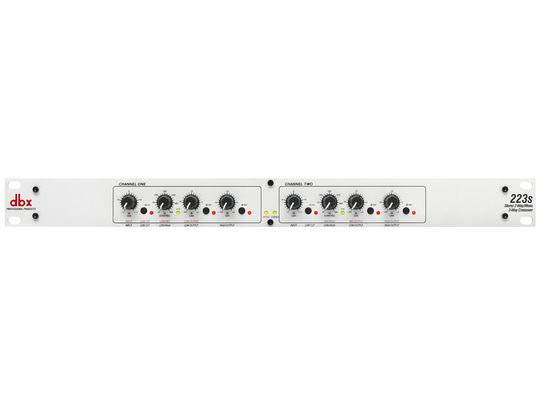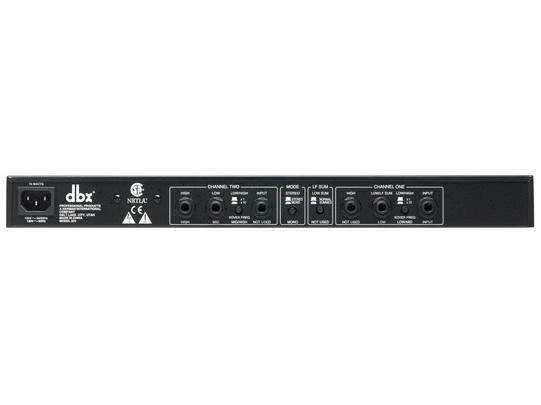223s
Stereo 2-Way/Mono 3-Way Crossover
More sound to your amps and speakers
The secret to making speakers sound great lies with the crossover you use. With the dbx® 223s Crossover you'll get great performance, ultra low-noise, rugged reliability and four decades of dbx knowledge and expertise in building the world's finest processors. The 223s uses precision filters to separate the audio signal and direct the correct frequencies to your loudspeaker drivers. By directing only the specific frequency bands to each speaker driver the 223s leaves your amplifiers free to use their full power on the usable signal eliminating distortion and giving your PA system a cleaner and better sound.
The dbx 223s is a dual channel crossover with all the features you would expect from a professional product. It features Linkwitz-Riley 24dB per octave filters, independent output gain controls for level matching, output phase inversion, 40 Hz low cut filter, and optional mono summing of the low frequency (subwoofer) output. Everything in the design exudes great precision from the solid "click" controls to the high quality 1/4" TRS ('s' model) or XLR ('xs' model) inputs and outputs.
- TRS differentially balanced ins and outs
- Mode switch for stereo 2-way or mono 3-way operation
- Low frequency summed (subwoofer) output
- x10 range switch on both channels
- 40Hz high pass (low cut) filter both channels
- Phase reverse switch on all outputs
- Individual level controls on all outputs
- 24dB per octave Linkwitz-Riley filters (the professional standard)
- Stereo/Mono status LEDs indicate the selected mode
- dbx® 2 year parts and labor as standard
- CSA NRTL/C approved
- CE compliant
| Input Connectors | 1/4" TRS |
| Input Type | Electronically balanced/unbalanced, RF filtered |
| Input Impedance | Balanced >50k ohm, unbalanced >25k ohm |
| Max Input | >+22dBu balanced or unbalanced |
| CMRR | >40dB, typically >55dB at 1kHz |
| Output Connectors | 1/4" TRS |
| Output Type | Impedance-balanaced/unbalanced, RF filtered |
| Output Impedance | Balanced 200 ohm, unbalanced 100 ohm |
| Max Output | >+21dBu balanced/unbalanced into 2k ohms or greater |
| Bandwidth | 20Hz to 20kHz, +/-0.5dB |
| Frequency Response | < 3 Hz to > 90 kHz, +0/-3 dB |
| Signal to Noise Ratio | Ref: +4 dBu, 22 kHz measurement bandwidth |
| Signal-to-Noise (Stereo Mode) | >94dB (Low Output), >91dB (High Output) |
| Signal-to-Noise (Mono Mode) | >94dB (Low Output), >93dB (Mid Output), >91dB (High Output) |
| Dynamic Range | > 106 dB, unweighted, any output |
| THD+Noise | < 0.004% at +4 dBu, 1 kHz; < 0.04% at +20 dBu, 1 kHz |
| Interchannel Crosstalk | < -80 dB, 20 Hz to 20 kHz |
| Crossover Frequencies (Stereo Mode) | Low/High: 45 to 960 Hz or 450 Hz to 9.6 kHz (x10 setting) |
| Crossover Frequencies (Mono Mode) | Low/Mid: 45 to 960 Hz or 450 Hz to 9.6 kHz (x10 setting); Mid/High: 45 to 960 Hz or 450 Hz to 9.6 kHz (x10 setting) |
| Crossover Filter Type | Linkwitz-Riley, 24 dB/octave, state-variable |
| Low cut Switch | Activates 40 Hz Butterworth, 12 dB/octave high-pass filter, one switch per channel. |
| Phase Invert Switch | Inverts the phase at the output, one switch per output. |
| x1 / x10 Switch | Multiplies the low-high(mono: low/mid and high/mid) crossover frequency range of the front-panel markings by a factor of 1 or 10, one switch per channel. |
| Mode Switch | Selects stereo/mono and 2/3-way operation |
| LF Sum Switch | Selects normal (stereo) or mono-summed low frequency operation and disables Ch 2’s low output phase invert LED to indicate that this output is not operational in the LF sum mode. |
| Indicators | Stereo Operation (Green); Mono Operation (Yellow); Low Cut (Red-per channel); x10 (Green-per channel); Phase Invert (Red-per output) |
| Operating Voltage | 100 VAC 50/60 Hz; 120 VAC 60 Hz 230 VAC50 HZ |
| Operating Temperature | 32°F to 113°F (0°C to 45°C) |
| Power Consumption | 15W |
| Power Connector | IEC receptacle |
| Dimensions | 1.75" H X 19" W X 6.9" D (4.4cm x 48.3cm x 17.5cm) |
| Unit Weight | 3.7 lbs. (1.7 kg) |
| Shipping Weight | 5.4 lbs. (2.5 kg) |
Find Your Local Retailer
Share this page
Copy and paste the link below to share this page:


dbx 223xs
Stereo 2-Way/Mono 3-Way Crossover with XLR Connectors
More sound to your amps and speakers…
View details

dbx 234s
Stereo 2/3 Way, Mono 4-Way Crossover
SKU: DBX0119
More sound to your amps and speakers…
View details

dbx 234xs
Stereo 2/3 Way, Mono 4-Way Crossover with XLR Connectors
More sound to your amps and speakers…
View details





